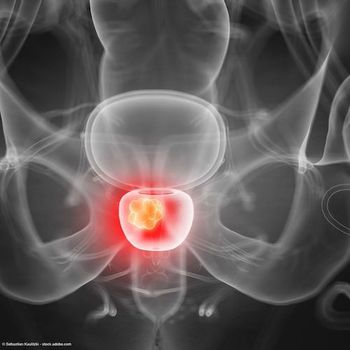
Urologists strive to personalize active surveillance plans for patients with low-risk prostate cancer
"Patients shouldn’t be making the decision to do active surveillance without understanding what that means and what their other options are,” one panelist said.
During a panel discussion at the 2023 LUGPA Annual Meeting, experts engaged in several case-based discussions designed to highlight the benefits and challenges when implementing an active surveillance management plan over immediate treatment in patients with low-risk prostate cancer.
Participating in the discussion were:
- Ronney Abaza, MD, Robotic Urologic & Cancer Surgery With Dr. Ronney Abaza, Dublin, Ohio
- Aaron D. Berger, MD, chief medical officer, director, Clinical Research, Associated Urological Specialists, Chicago, Illinois
- David Crawford, MD, professor, surgery, radiation oncology, head, Urologic Oncology, the University of Colorado Denver School of Medicine
- David Morris, MD, FACS, urologist, Urology Associates of Nashville, Tennessee
“Active surveillance, although it’s certainly an option that’s been around forever, came into a more active part of our discussion about 10 years ago. It’s a good time to try to get to next-level questions about how we’re managing [prostate cancer using active surveillance] today,” one panelist noted as the rationale for this presentation.
Keeping Active Surveillance Active
The discussion began by introducing a case of a 62-year-old patient with a prostate-specific antigen (PSA) level of 6.3 ng/dL. This patient had a family history of prostate cancer in their father (age 67 years at diagnosis) and breast cancer in a paternal aunt (age 54 years at diagnosis). Biopsy results showed that this patient had Gleason Group 1 disease in a maximum of 40% of 5 out of 12 cores. The patient’s prostate measured 43 g with a PSA density of 0.146.
The panelists unanimously agreed that active surveillance was appropriate in this case.
“This is a true example of shared decision making in that a patient shouldn’t be making the decision to do active surveillance without understanding what that means and what their other options are,” one panelist said.
However, the generalizability of active surveillance across the prostate cancer population was brought into question. “We don’t want to find patients for active surveillance; we want to find patients who need to be treated,” another panelist challenged. “[We have been] biopsying patients who shouldn’t have been biopsied. When we first started doing biopsies, we weren’t seeing [the need for active surveillance]. A lot of this is related to PSA [levels]…and size of the prostate. I think we need to step back…. We want to go back and prevent us from getting patients for active surveillance…. I want to see more patients who are actually getting treated who were biopsied.”
“We do want to make sure we’re not overtreating the cancer we’re finding,” another participant emphasized.
The panelists discussed the pathways that their practices have in place to implement active surveillance when appropriate and monitor patient adherence to National Comprehensive Cancer Network (NCCN) recommendations.
“I think our pathway is something novel compared with most other pathways based on NCCN guidelines,” one of the panelists said. “We use data analytics, which I think is a key point in this, because just like any other patient in any other disease state but certainly in prostate cancer, a lot of patients get lost to follow-up. I tell all my patients going on active surveillance that [their] part of active surveillance is that they have to actually come back. It’s not active surveillance if they…come back 5 years later and then we miss something, and they have advanced disease now. Having whatever data platform you use to [see whether] the patient has had [photodynamic therapy] within the past 6 to 9 months or whether they’ve had magnetic resonance imaging [MRI] in the past 2 years helps with adherence, because certainly there is a wide variability with all things in prostate cancer among our colleagues who don’t [conduct active surveillance often].”
Another speaker described the crucial nature of patient adherence to surveillance procedures, explaining the case of a patient they saw recently who was diagnosed with Gleason Group 6 prostate cancer in 2018 and only underwent PSA level monitoring until 2023, when he received an MRI and was diagnosed with more advanced disease. “One of the things that being part of a large group enables you to do is have a prostate cancer navigator,” the panelist emphasized. “Patients need to understand that…active surveillance involves surveillance. You do need to follow up and carefully monitor and assess for progression because…if you follow these patients long enough, a large proportion of them are going to progress and have treatment. In the real world, there’s also a decent proportion of patients who are misidentified as low risk…and if they’re not followed, those patients will not be identified.”
Another participant concurred, saying, “we have the tools to find patients who need to be treated.” However, they expressed the limitations of MRIs, and advocated for increased use of PSA testing and molecular testing. “These tests are helpful for following patients,” they noted. “A lot of these tests, like Select mdx…will tell you your risk of having high-grade cancer.”
“All patients on active surveillance should be offered genomic testing,” one of the panelists said, noting that test results can confirm that a patient has low-risk disease and support the decision to conduct active surveillance. Conversely, if the tests indicate that the patient has high-risk disease and is not a candidate for surveillance, they explained that patient communication is crucial, so patients are prepared to undergo a confirmatory biopsy or repeat imaging and begin treatment if needed.
Another participant detailed their change in practice away from biopsies, saying, “My routine prior to the MRI era was to do an immediate confirmatory biopsy….Now that we have MRIs, my routine for the patient who’s seeing me in their first consultation for low-risk disease is to do the MRI if they haven’t already had it, as well as a genomic test….If those are both favorable, we put them on surveillance.”
Testing for Biomarkers
The panelists shifted to a case discussion about a 53-year-old patient with Gleason Group 2 disease who otherwise had the same disease characteristics and family history as the patient from the first case discussed in the presentation.
In a discussion regarding the favorability of active surveillance in this patient, one panelist explained that the 2 types of patients who begin active surveillance are those who will likely die of causes other than prostate cancer and those who are not currently interested in treatment but may decide to begin treatment in the future. This speaker emphasized that active surveillance is often a reasonable decision for younger patients for whom treatment is not urgent.
Another participant highlighted that the case patient’s family history of breast cancer might sway their active surveillance decision because of the potential for BRCA-mutated disease. Although patients with BRCA-mutated prostate cancer are candidates for active surveillance, this participant recommended closely following these patients.
Monitoring Changes in PSA Levels
Regarding the variety of methods for monitoring patients on active surveillance, one panelist noted that older, highly symptomatic patients with low-grade disease may not need close monitoring through active surveillance if they have a short life expectancy. Instead, a watchful waiting approach may be most amenable to their disease and comorbidities.
“We should be purposeful in why we’re doing biopsies,” another panelist added.
However, a third panelist expressed that requiring a consistent monitoring protocol for all patients on active surveillance may increase rates of active surveillance adoption and adherence in the urology field.
Strategically Ending Active Surveillance
The panelists concluded by discussing their methods for transitioning patients off active surveillance protocols. These strategies included refraining from making changes to patients’ treatments solely based on PSA levels. Rather, results from MRIs or biopsies should contribute to these decisions.
As with all other aspects of the active surveillance protocol, the panelists emphasized the importance of including patients in the decision-making process when determining the optimal timing of and approach toward ending active surveillance. Patient preference can help guide the decision to either begin treatment based on MRI results or defer treatment until after the patient undergoes a confirmatory biopsy. If a confirmatory biopsy is conducted, the panelists agreed that several facets of the biopsy results, including the number of affected cores and Gleason Group score, contribute to the choice to initiate treatment. Additionally, patient age, health, and life expectancy play a role in determining which treatment strategies to pivot toward, if any.
Newsletter
Stay current with the latest urology news and practice-changing insights — sign up now for the essential updates every urologist needs.




















